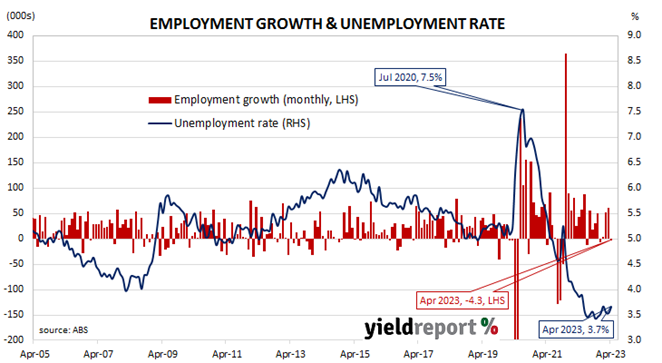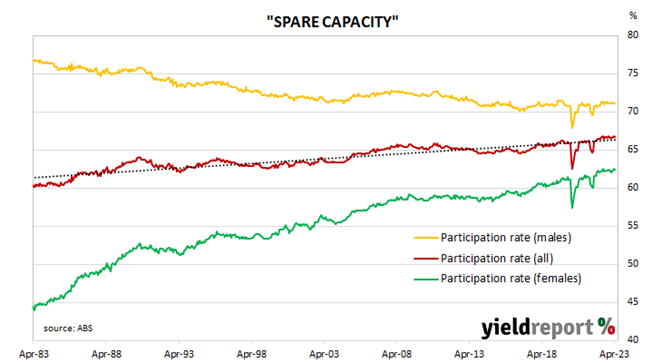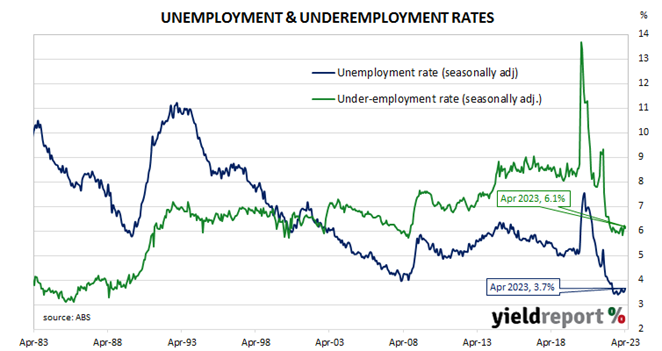Summary: Employment down 4,300 in April, contrasts with expected gain; ANZ: part of weakness a reversal from gains in Feb, Mar; MSA: “noise” in this month’s report tempers “signal” to RBA; participation rate slips to 66.7%; jobless rate rises to 3.7%; more part-time, fewer full-time jobs; aggregate work hours up 2.6%; MSA: hours worked increase has “interesting implications” for RBA’s productivity focus; underemployment rate ticks down to 6.1%.
Australia’s period of falling unemployment came to an end in early 2019 when the jobless rate hit a low of 4.9%. It then averaged around 5.2% through to March 2020, bouncing around in a range from 5.1% to 5.3%. Leading indicators such as ANZ-Indeed’s Job Ads survey and NAB’s capacity utilisation estimate suggested the unemployment rate would rise in the June 2020 quarter and it did so, sharply. The jobless rate peaked in July 2020 but fell below 7% a month later and then trended lower through 2021 and 2022.
The latest Labour force figures have now been released and they indicate the number of people employed in Australia according to ABS definitions decreased by 4,300 in April. The decline contrasted with the 25,000 increase which had been generally expected as well as March’s 61,100 gain after revisions.
“Part of this weakness is a reversal from gains in February and March, and despite the monthly dip, 108,000 workers were added to the economy in the three months to April,” said ANZ senior economist Adelaide Timbrell.
Domestic Treasury bond yields increased materially on the day, aided by higher yields in US Treasury markets overnight. By the close of business, the 3-year ACGB yield had gained 8bps to 3.20%, the 10-year yield had added 6bps to 3.49% while the 20-year yield finished 5bps higher at 3.94%.
In the cash futures market, expectations regarding rate cuts in 2024 softened. At the end of the day, contract prices implied the cash rate would remain essentially steady at the current rate of 3.82% to average 3.845% in June and 3.90% in July. February 2024 contracts implied a 3.805% average cash rate while May 2024 contracts implied 3.62%, 20bps less than the current rate.
“This print increases the unemployment rate above the RBA’s mid-2023 forecast, although the noise in the monthly data will temper the signal it takes from a single data point,” said Morgan Stanley Australia economist Chris Read. He expected the RBA to retain its tightening bias given “forward indicators are still suggesting only gradual softening in conditions, and wage growth is likely to accelerate over 2H2023.”
The participation rate slipped from March’s upwardly revised figure of 66.8% to 66.7% as the total available workforce increased by 14,100 to 14.410 million while the number of unemployed persons increased by 18,400 to 528,000. As a result, the unemployment rate rose from 3.5% to 3.7%.
The aggregate number of hours worked across the Australian economy increased by 2.6% even as 22,900 residents gained part-time positions and 27,200 residents lost full-time positions. On a 12-month basis and after revisions, aggregate hours worked increased by 7.4% as 49,500 more people held part-time positions and 283,400 more people held full-time positions than in April 2022.
Morgan Stanley’s Read made a thought-provoking observation regarding the aggregate hours figure. “The strong increase in hours worked also has interesting implications for the RBA’s recent productivity focus – higher hours worked and weaker output suggests lower productivity, effectively increasing the inflationary impact of a given level of wages growth.”
More attention has been paid to the underemployment rate in recent years, which is the number of people in work but who wish to work more hours than they do currently. April’s underemployment rate ticked down from 6.2% to 6.1%, 0.3 percentage points above this cycle’s low.
The underutilisation rate, that is the sum of the underemployment rate and the unemployment rate, has a strong correlation with the annual growth rate of the ABS private sector wage index when advanced by two quarters. April’s underutilisation rate of 9.9% corresponds with an annual growth rate of about 4.3%.




